Solar panels are amazing, you put them in the sun, and they produce power.
But for a solar panel to produce maximum power, it needs to be well-oriented. This is because the more direct sunlight a solar panel receives, the more power it’ll produce.
But, do solar panels need direct sunlight to work? can they work when it’s cloudy? What if a solar panel is under shade, will it produce power?
In this article, I’ll answer all of these questions.
Do solar panels need direct sunlight?
When a solar panel is under the sun, it not only converts direct sunlight into electrical power but also converts indirect sunlight (also referred to as Diffuse Solar Radiation).
Solar panels don’t need direct sunlight to work. However, they can only produce their rated output under direct sunlight. For example, a 100W solar panel will only produce 100 Watts of power if it’s directly facing the sun.
The amount of power a solar panel produces depends directly on how much sunlight is accessing it. This sunlight is generally the sum of direct, diffuse, and reflected sunlight.
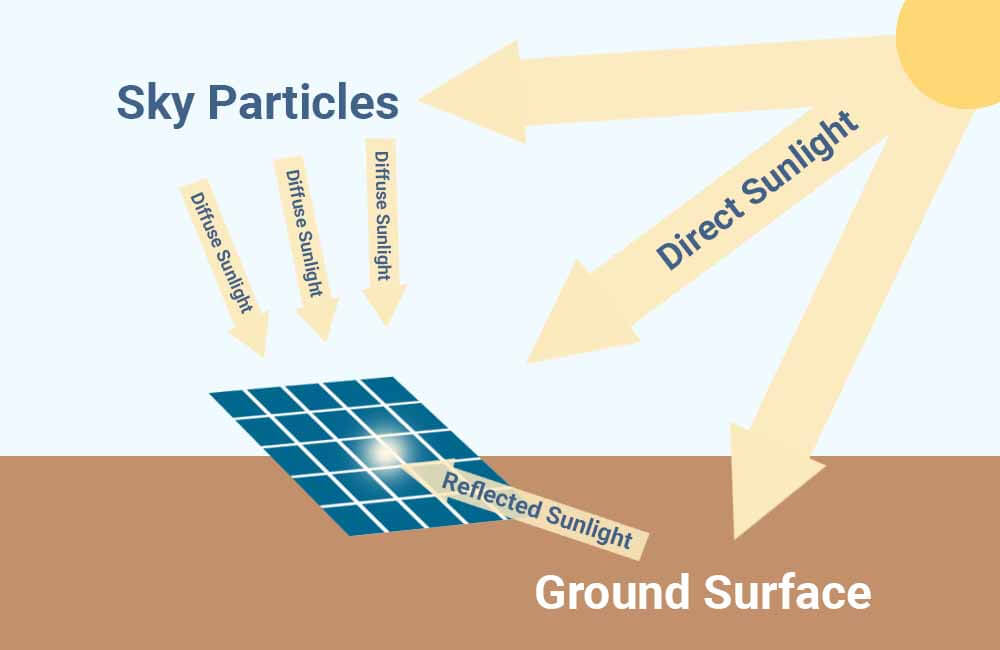
Reflected sunlight only represents a small portion of the sunlight a solar panel receives, so, it can generally be neglected.
The amount of sunlight a solar panel receives can be then represented as such:
Received Sunlight = Direct Sunlight + Diffuse Sunlight
- Direct sunlight: the amount of direct sunlight a solar panel receives depends on its orientation.
- Diffuse Sunlight: the amount of diffuse sunlight a solar panel receives is generally the same regardless of its orientation.
The amount of sunlight that a solar panel, or a surface in general, receives is referred to as Solar Irradiance and is generally measured in Watts per Square Meter (W/m²).
In order for a solar panel to reach its peak output, it needs exactly 1000W/m² of solar irradiance. In the real world, a solar panel can only receive this amount of sunlight if it’s directly facing the sun.
For example, a solar panel located somewhere in the US should generally face south, if it’s facing the north it will get little to no direct sunlight, and will therefore only be accessing diffuse sunlight.
In the summer, when the sky is perfectly clear and the sun is very high in the sky, diffuse sunlight only represents about 20% of the total sunlight. This means that without direct sunlight, the solar panel will work, but will only produce about 20% of its rated output.
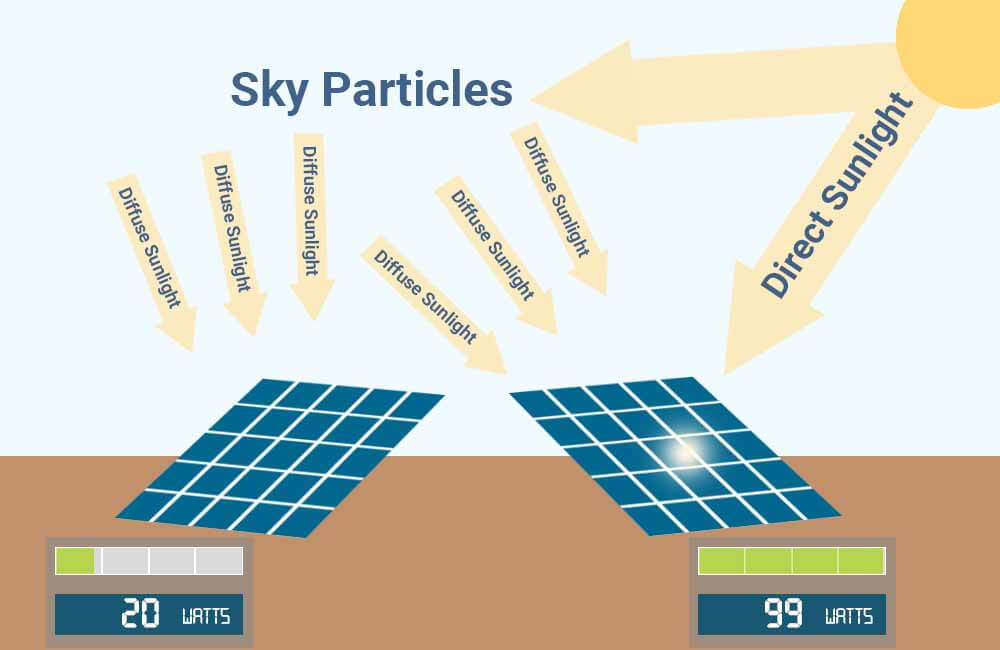
For example, the image above shows 2 100W solar panels.
The solar panel that’s directly facing the sun is making use of both direct and indirect sunlight and is producing maximum power.
The solar panel on the left mostly receives indirect sunlight and is producing 20% of its rated power.
This is why it is important to adjust the orientation of your solar panel(s).
In the US, solar panels are generally installed in a south-facing direction and are generally tilted at about 45°. Because with this setup, solar panels have the most access to direct sunlight.
To learn more about solar panel angles and directions, feel free to check this article on how to increase solar panel output.
How much sunlight do solar panels need?
Sunlight is measured in W/m² (watts per square meter), with 1000W/m² representing perfectly clear sunny skies, and 0W/m² representing complete darkness.
A solar panel needs 1000W/m² of sunlight to produce 100% of its rated output. For example, a 100W solar panel can only produce 100 watts of power under peak sun (1000W/m² of sunlight). If it’s a little cloudy and the same panel only receives 500W/m² of sunlight, it would only produce 50 Watts of power.
As mentioned above, the amount of sunlight a surface receives is referred to as Solar Irradiance. And solar irradiance depends mainly on weather conditions.
For example, consider this 100 Watt solar panel with the following specifications:
- Rated current (Impp): 5.86 Amps
- Rated Voltage (Vmpp): 17.1 Volts
- Output Power (Pmpp): 100 Watts
The following table shows you how the current, voltage, and power of this solar panel respond to different amounts of sunlight:
| Weather | Cloudy | Mostly Cloudy | Partly Sunny | Mostly Sunny | Perfectly Sunny |
| Solar Irradiance | 200W/m² | 400W/m² | 600W/m² | 800W/m² | 1000W/m² |
| Output Current in Amps (Impp) | 1.18 A | 2.34 A | 3.52 A | 4.68 A | 5.86 A |
| Output Voltage in Volts (Vmpp) | 15.7 V | 16.1 V | 16.5 V | 16.9 V | 17.1 V |
| Output Power in Watts (Pmax) | 18.5 W | 38 W | 58 W | 79 W | 100 W |
When trying to figure out how much energy a solar panel or a solar array produces, we basically need to know what the power production is for a certain period of time.
Please note that electrical energy is not the same as electrical power. Energy is measured in Watt-hours (Wh) and is the power produced for a certain period of time. It is calculated as such: Energy = Power x Time.
For example, if we wanted to calculate how much energy the solar panel from our example would produce in 2 hours, in weather that’s mostly sunny (800W/m²). This is how it’s done:
- Power (at 800W/m²) = 79 Watts
- Time = 2 hours
Energy (Wh) = Power (W) x Time (hours)
Energy (Wh) = 79W x 2 hours
Energy (Wh) = 158 Watt-hours
However, since it would be too complicated and confusing to track how much power a solar panel produces and for how long, Peak Sun Hours are used to estimate how much energy a solar system would produce in a certain location.
Peak Sun Hours represents the amount of sunlight energy that a certain location receives per day. For example, a location that receives 5kWh/m² (5000Wh/m²) of sunlight energy per day, can be said to receive 5 Peak Sun Hours per day.
If we placed a 100 Watt solar panel in this location, it would produce 500Wh/day (500 Watt-hours of energy per day):
Energy Production per day (Wh/day) = Rated Power x Peak Sun Hours
Energy Production per day (Wh/day) = 100W x 5 hours
Energy Production per day (Wh/day) = 500 Watt-hours per day
So how many Peak Sun Hours do you get?
There are a few resources that provide this information, such as the PVWatts Calculator from the National Renewable Energy Laboratory (NREL).
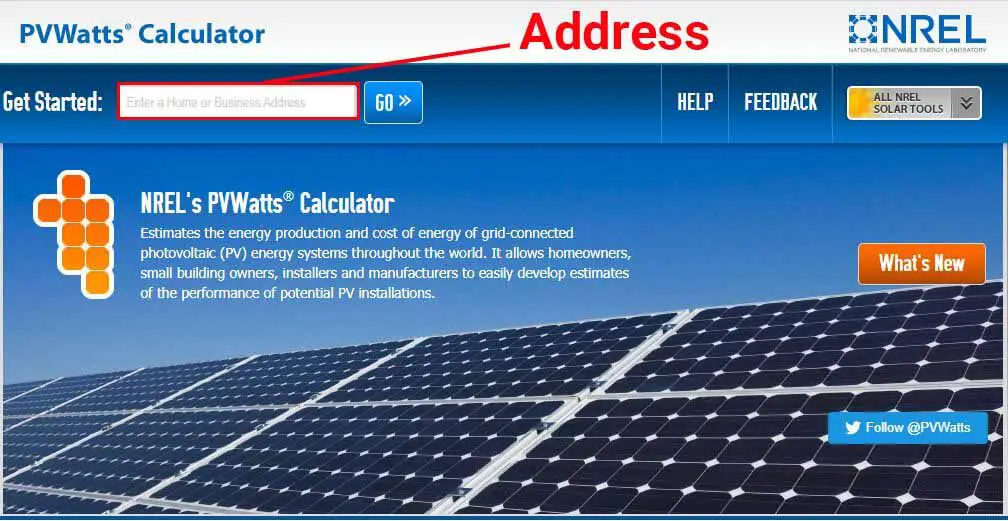
All you have to do is submit an address and the tool will generate all the Peak Sun Hours data you need.
For example, let’s say I have 300 watts of solar panels located in Tuscon, AZ.
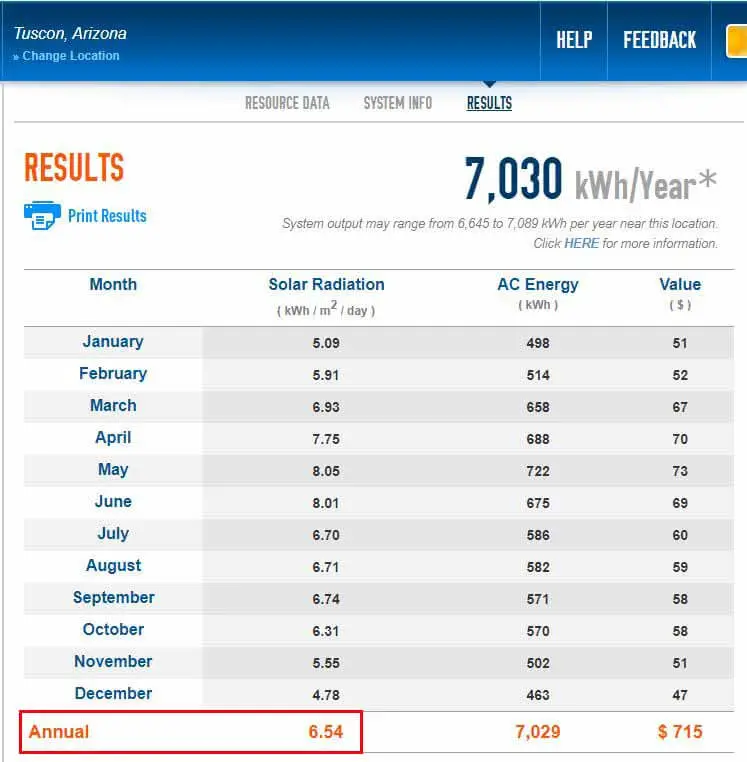
On average, this location receives 6.54 Peak Sun Hours per day, so the average energy production of the solar panels is:
Energy Production per day (Wh/day) = Rated Power x Peak Sun Hours
Energy Production per day (Wh/day) = 300W x 6.54 hours
Energy Production per day (Wh/day) = 1962 Watt-hours per day
With the PVWatts calculator, you can also submit the specifications of your system in the system info section, and the tool will estimate the monthly and yearly energy production.
Do solar panels work in the shade?
Solar panels work best under direct sunlight, but will solar panels still work in the shade?
When a solar panel is equally shaded, its output power is so low that it’s negligible. When a solar panel is only partially shaded, it can still produce power. However, with partial shading, the amount of power a solar panel produces depends on which of its cells are shaded and how many bypass diodes it has.
A solar panel consists of series-connected solar cells, which is referred to as a string. All of the cells in the string produce their own voltage but share the same current.
When a single cell is shaded, it generally still receives a low amount of diffuse sunlight, its voltage won’t be much affected, but its current will be proportional to the amount of light it receives.
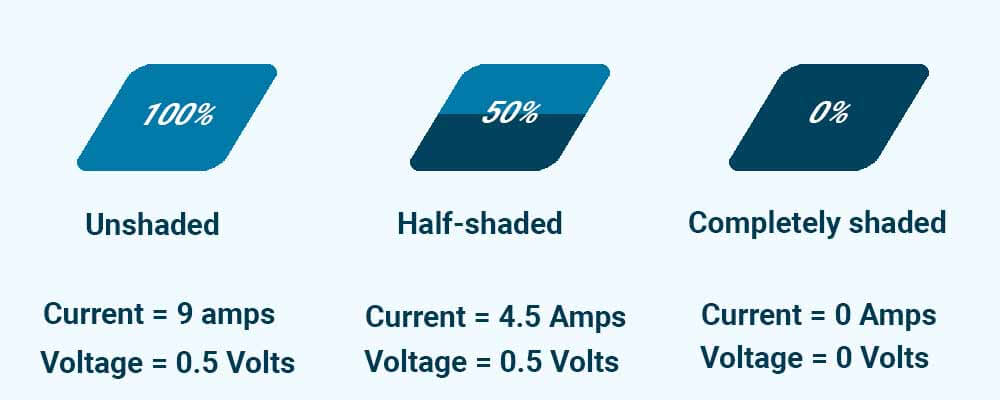
For example, if the cell receives 1000W/m² of sunlight, it’ll produce maximum current. If the cell is shaded, and only receives 50W/m², it’ll produce 5% of its rated current.
Related: Effects of shade on a single solar cell
Individually, these cells are capable of producing their own voltage and current. However, with a series connection, the total voltage of the string is the sum of all the voltages from each cell, and the total current from the string is the same across all the cells.
When a solar panel is completely shaded and all of the cells receive a very low but equal amount of sunlight, the current produced by all the cells will be equal (ex. 5% of their rated current). And as long as the panel still receives a little light, the voltage will essentially stay the same.
In the case of equal shading, the amount of power a solar panel produces is proportional to the amount of light it receives. However, with partial shading, the losses in power production are disproportional to how much of the solar panel is shaded.
Related: How much does partial shade affect solar panel output?
If only one cell is shaded, the total current will be limited to the current produced by the shaded cell.
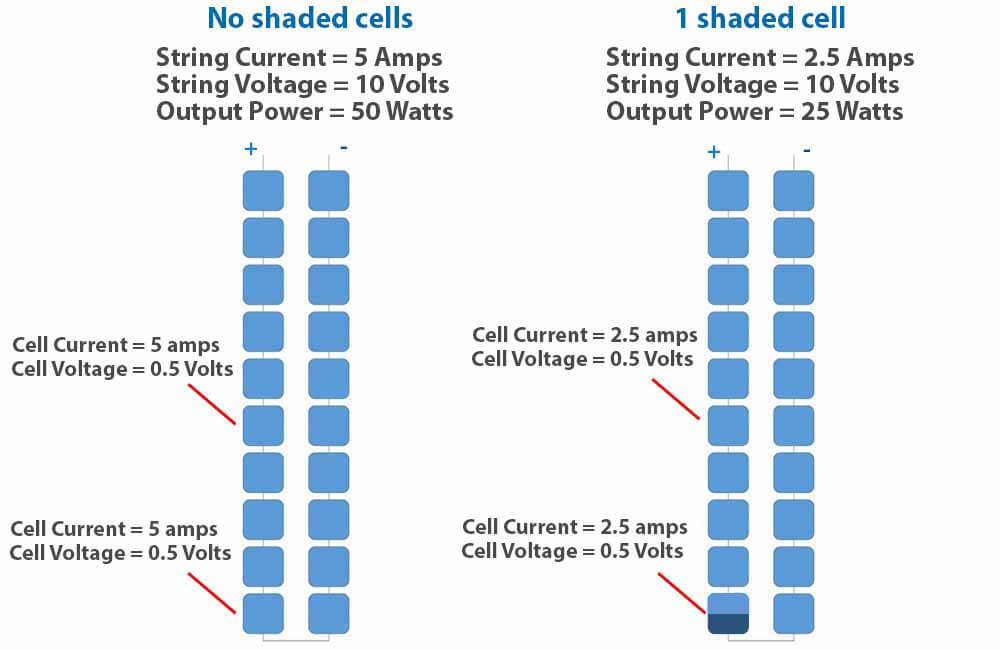
The shaded cell takes the excess current, consumes it, and dissipates it into heat. This can cause hotspots and the overall degradation of the solar panel.
For this reason, solar manufacturers equip their solar panels with bypass diodes.
For example, the image below shows a 60 cell solar panel with 3 bypass diodes. 1 bypass diodes for every 20 cells.
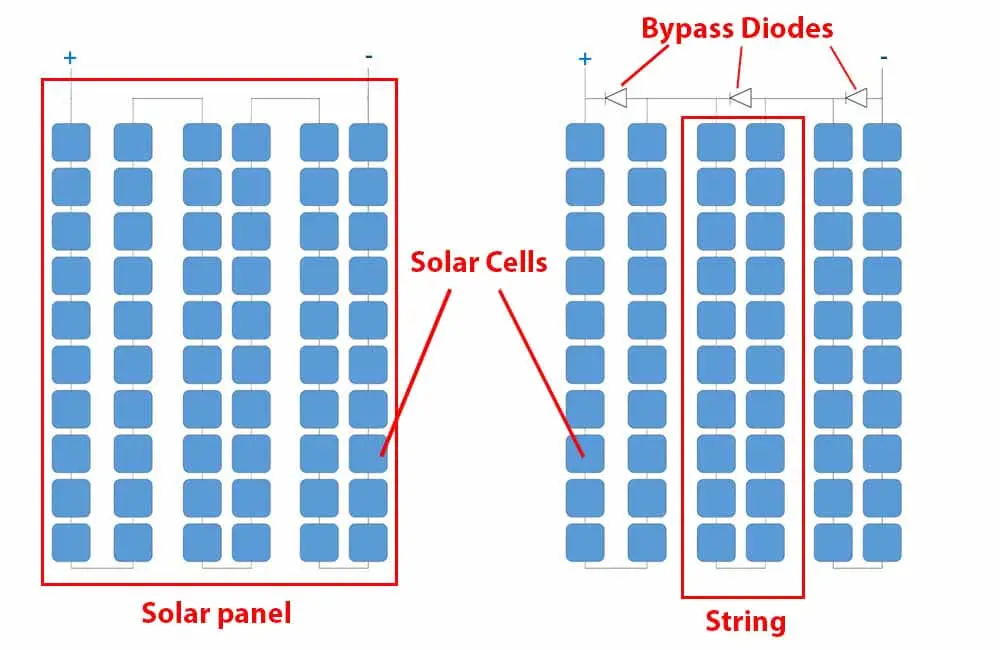
Each bypass diode is connected in parallel with a string of cells and allows the current to flow in the right direction in case of partial shading.
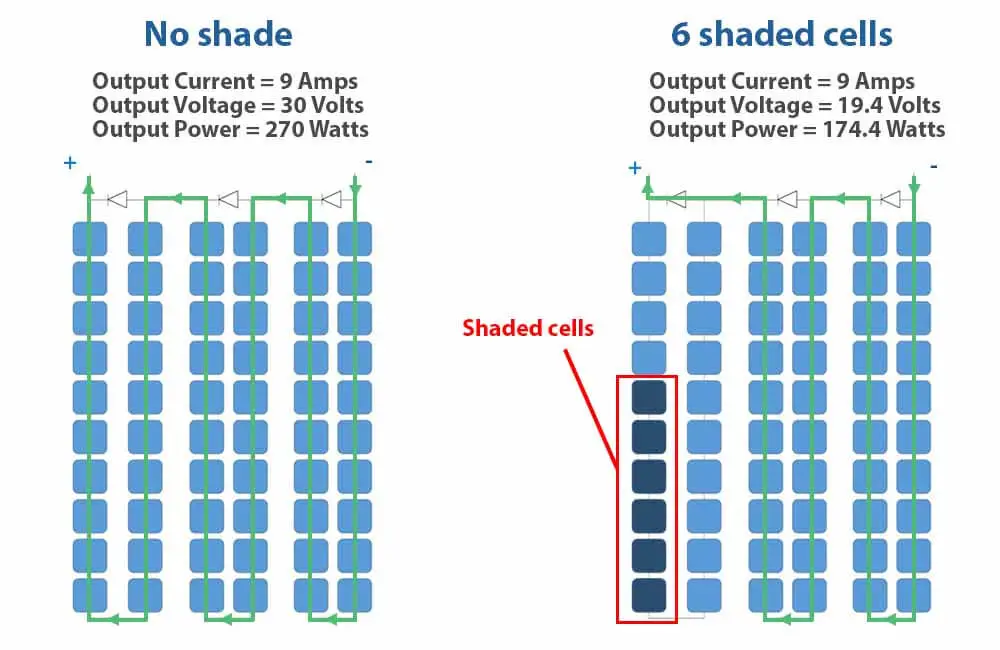
With bypass diodes, the losses in power production are reduced but are still disproportionate.
For example, in the image above, you can see that while only 10% of the solar panel is shaded, around 30% of production is lost. In other cases, the losses can be more severe.
To read more about solar panel shading and look at more examples, please refer to this article: Do solar panels work in the shade?
The article contains a detailed explanation of solar panel shading, its effect, and potential solutions.
How to increase solar panel output?
Solar panels use light to create electrical potential and current and therefore, produce power. However, the power production will not always be as high as it could be.
There are a few things that you can do to maximize the power production and to 100% make use of your solar panels.
1. Adjust solar panel angle and direction
When you set up a solar panel, you’re essentially creating a surface that converts the sunlight hitting it, into electrical power.
And given that different surfaces receive different amounts of sunlight, you would want to set up your solar panel in a way that it receives maximum sunlight.
The more direct sunlight a solar panel receives, the more power it produces.
One way to make sure that a solar panel receives as much direct sunlight as possible is the sundial method:
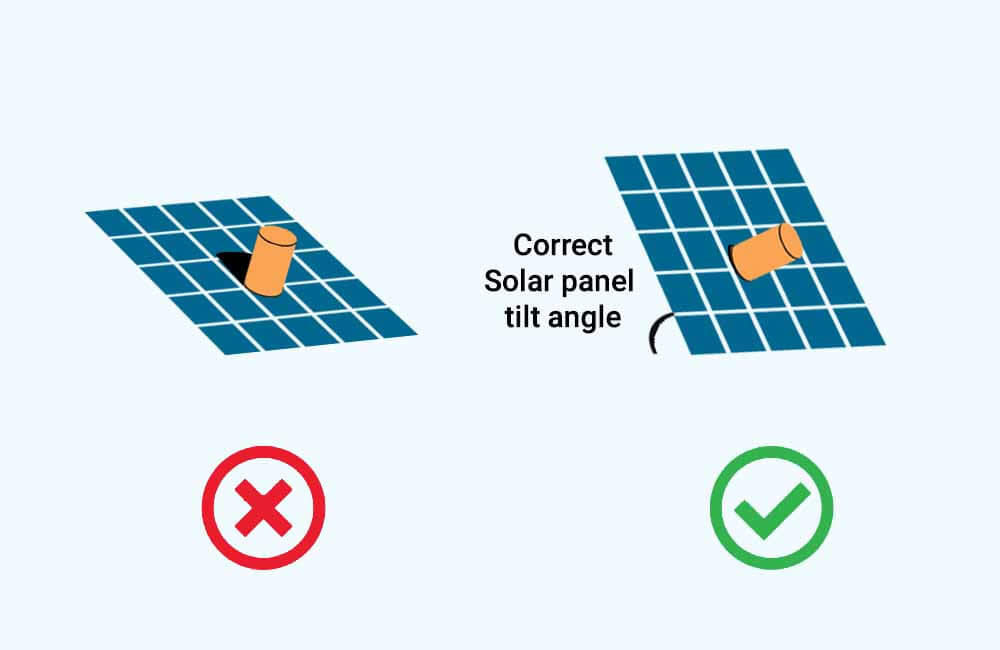
All you have to do is direct the solar panel so that it faces the sun, place an object on the solar panel, and keep adjusting the panel’s angle until the shadow cast by the object is least visible.
The following video shows how this can be done.
However, since the location of the sun changes throughout the day, you’d have to change the angle and direction every half an hour or so, which can be time-consuming and inefficient.
In this article about increasing solar panel output, I provide a couple of tables that give you the best orientation for your solar panels based on the time of day and the time time of year.
2. Use an MPPT solar charge controller.
Although solar charge controllers were initially used to protect the solar panels and the battery, MPPT charge controllers can also increase the output.
MPPT stands for Maximum Power Point Tracking, and the technology ensures that solar panels operate at the proper Voltage and Current, which in turn ensure maximum power production.
PWM charge controllers lower the voltage from the solar panels to safely charge the battery. The voltage drop causes losses in power production (20%-30% losses).
On the other hand, instead of just lowering the voltage, MPPT charge controllers transform the power produced by the solar panel to a lower voltage/higher current power.
To read more about this, check out this article on how MPPT charge controllers work.
If you already know about MPPTs, you can use our MPPT solar charge controller calculator to choose the best MPPT for your system.
3. Clean if necessary
Same as shading, one dirty solar cell can significantly decrease power production.
So if your solar panel is not performing as it should, make sure to check for dirt, bird poop, leaves, etc…
FAQs
What time of day are solar panels most efficient?
Technically, the efficiency of a solar panel does not change relative to the time of day. However, solar panels produce the most power at noon.
From 10H to 14H, the sun is very high in the sky, and direct sunlight is more available.
What month is best for solar panels?
In the United States or the northern hemisphere in general, June, July, and August are the best months to produce solar power. In these months, locations in the northern hemisphere receive the highest amount of solar irradiance.
In Australia or the southern hemisphere in general, November, December, and January are the best months for solar panels.
Do solar panels work better in the cold?
Generally, solar panels work best in the summer because sunlight is more available. However, at lower temperatures, the voltage at the terminals of a solar panel is higher. Theoretically, if you could give a solar panel the same amount of sunlight with colder temperatures, you could get a higher output power.
In the winter, the sun is closer to the horizon, which means less direct sunlight for the solar panels. But since it is colder, on a sunny winter day, solar panels produce somewhat the same amount of power as they would on a sunny summer day.
Do solar panels need the sun or just light?
Solar panels don’t necessarily need the sun to produce power. However, solar panels need 1000W/m² of light energy to produce 100% of their rated power. In the real world, this amount of light is provided by the sun.
Theoretically, if you could provide the same amount of energy from artificial light, you would have maximum output power from the solar panel.
Furthermore, manufacturers actually test the outputs of solar panels with artificial light.

